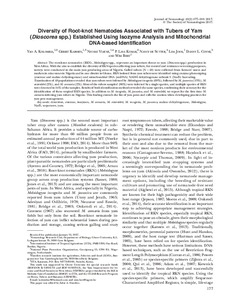| dc.contributor.author | Kolombia, Y.A. |
| dc.contributor.author | Karssen, G. |
| dc.contributor.author | Viaene, N. |
| dc.contributor.author | Kumar, P.L. |
| dc.contributor.author | Sutter, N. de |
| dc.contributor.author | Joos, L. |
| dc.contributor.author | Coyne, D.L. |
| dc.contributor.author | Bert, W. |
| dc.date.accessioned | 2019-12-04T11:09:16Z |
| dc.date.available | 2019-12-04T11:09:16Z |
| dc.date.issued | 2017-06 |
| dc.identifier.citation | Kolombia, Y.A., Karssen, G., Viaene, N., Kumar, P.L., de Sutter, N., Joos, L., ... & Bert, W. (2017). Diversity of root-knot nematodes associated with tubers of yam (Dioscorea spp.) established using isozyme analysis and mitochondrial DNA-based identification. Journal of Nematology, 49(2), 177-188. |
| dc.identifier.issn | 0022-300X |
| dc.identifier.uri | https://hdl.handle.net/20.500.12478/2012 |
| dc.description.abstract | The root-knot nematodes (RKN), Meloidogyne spp., represent an important threat to yam (Dioscorea spp.) production in West Africa. With the aim to establish the diversity of RKN species affecting yam tubers, for control and resistance screening purposes, surveys were conducted in the main yam producing areas of Nigeria. Galled tubers (N = 48) were collected from farmers’ stores and markets in nine states in Nigeria and in one district in Ghana. RKN isolated from yam tubers were identified using enzyme phenotyping (esterase and malate dehydrogenase) and mitochondrial DNA (mtDNA) NADH dehydrogenase subunit 5 (Nad5) barcoding.
Examination of 48 populations revealed that yam tubers were infested by Meloidogyne incognita (69%), followed by M. javanica (13%), M. enterolobii (2%), and M. arenaria (2%). Most of the tubers sampled (86%) were infected by a single species, and multiple species of RKN were detected in 14% of the samples. Results of both identification methods revealed the same species, confirming their accuracy for the identification of these tropical RKN species. In addition to M. incognita, M. javanica, and M. enterolobii, we report for the first time M. arenaria infecting yam tubers in Nigeria. This finding extends the list of yam pests and calls for caution when developing practices for yam pest management. |
| dc.description.sponsorship | Bill & Melinda Gates Foundation |
| dc.format.extent | 177-188 |
| dc.language.iso | en |
| dc.subject | Esterase |
| dc.subject | Isozymes |
| dc.subject | Meloidogyne Arenaria |
| dc.subject | Meloidogyne Incognita |
| dc.subject | Meloidogyne Javanica |
| dc.subject | Malate Dehydrogenase |
| dc.subject | Meloidogyne |
| dc.subject | Yams |
| dc.subject | Dna |
| dc.subject | Root-Knot Nematodes |
| dc.subject | Nad5 |
| dc.subject | Sequences |
| dc.title | Diversity of root-knot nematodes associated with tubers of yam (Dioscorea spp.) established using isozyme analysis and mitochondrial DNA-based identification |
| dc.type | Journal Article |
| dc.description.version | Peer Review |
| cg.contributor.crp | Roots, Tubers and Bananas |
| cg.contributor.affiliation | Ghent University |
| cg.contributor.affiliation | International Institute of Tropical Agriculture |
| cg.contributor.affiliation | National Plant Protection Organization, Netherlands |
| cg.contributor.affiliation | Flanders Research Institute for Agriculture, Fisheries and Food, Belgium |
| cg.coverage.region | Africa |
| cg.coverage.region | West Africa |
| cg.coverage.country | Nigeria |
| cg.isijournal | ISI Journal |
| cg.authorship.types | CGIAR and advanced research institute |
| cg.iitasubject | Disease Control |
| cg.iitasubject | Plant Diseases |
| cg.iitasubject | Plant Genetic Resources |
| cg.iitasubject | Yam |
| cg.journal | Journal of Nematology |
| cg.howpublished | Formally Published |
| cg.accessibilitystatus | Limited Access |
| local.dspaceid | 85748 |
| cg.targetaudience | Scientists |

